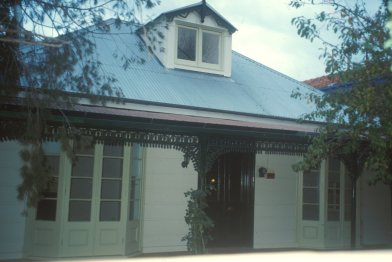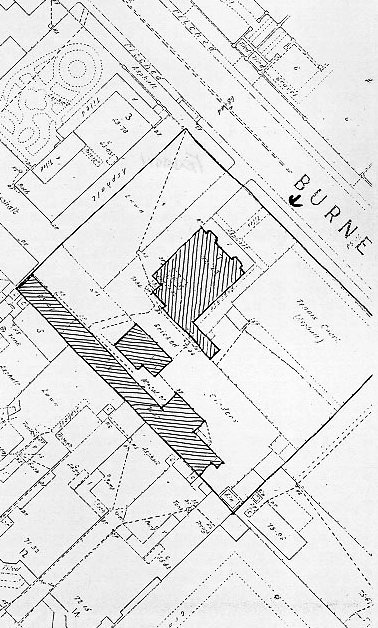|
|
|
Home | Introduction | Contents| Feedback | Map | Sources | Glossary |
|
25
Fenagh Cottage
Miles Lewis observed that John Butler Cooper, writing in 1930, recorded “a surprising large number of prefabricated iron or timber buildings surviving in St Kilda then. Fifty years later, Lewis found that of these, only Fenagh Cottage had survived. In suburbs nearer to the city, such as South Melbourne, North Melbourne and Fitzroy, redevelopment had not been as intense; far fewer blocks of flats had emerged in the 1930s and 40s and a few small, prefabricated houses had survived.
Fenagh Cottage, 2002
Fenagh
stands on part of Crown Allotment 25, bought from the Crown by F.G. Dalgety (23)
in 1846 for £90, part of a much larger estate known as Dalgety’s Paddock.
Dalgety subdivided this in 1854 and returned to
But Langlands, who
lived in a substantial house at Jolimont, and owned much other property in the
colony, sold the following year at a tidy profit to William (or Patrick?)
Cleary, for £1,500. By 1855, James Kearney’s map
shows a cluster of small buildings at
By 1858 the property’s value had fallen and Watson purchased it for a tidy £1,000. He also bought lots 37 and 38 adjacent for £600 from David Guthrie who had also purchased from Dalgety for £520. In property speculation, timing is crucial.
Fenagh Cottage: MMBW Detail Plan, 1897
But at
George John Watson (1829-1906) was born in the
tiny
As the boom of the gold rush subsided, no
coaching contractor could operate profitably without the support of a government
mail contract: the post effectively subsidised public transport. It must have
been more profitable for Watson and Hewitt to sell their Cobb & Co services to
buy the subsidised Beechworth service, even though its population was not
increasing at the rate of Ballarat and
In 1857-58, Watson and Hewitt’s Beechworth run
was managed by a young American, James Rutherford who reduced the
Cobb & Co’s previous owners were Canadians A.W. Robertson and John Wagner. Watson left the partnership with Hewitt in 1862, but remained in the coaching business and was a partner in Robertson & Co until 1880. That management of coaching companies was so personal is exemplified by Watson’s famous feat in 1868, of driving one of the Beechworth coaches to Melbourne in only 15 hours including a ‘far from hasty’ meal at Avenal. Watson and Hewitt bred, trained and rested numerous horses on properties they leased until 1862 in the Riverina, the Darling and near Pakenham, where he owned almost 2,000 hectares over 1872-84.
Watson was a member of the committee of the
Victoria Racing Club when it was founded in 1864. He remained an owner of
racehorses, a VRC starter and committee member into his old age. He was a
spectacular cross-country and steeplechase rider and wearing his colours of red
and black, his horse won the first Oaks Stakes in 1861 and the
But he is perhaps most famous as founder of
the Melbourne Hunt Club in 1853, two years before he moved to
Fenagh
Cottage resounded to Watson’s hunting horn, as Heather Roland describes: ‘at
many a before-daylight hunt riders would come hurrying (to
Hunters included: Adam Lindsay Gordon, W.F. Stawell, (later Chief Justice), (later Sir) John Madden (29), Mars Buckley (owner of Buckley and Nunn’s Department Store) and Henry Creswick. All nine Watson sons and his daughter Blanche were fine horse riders. The sons were known for their wildness. It is difficult to imagine this family of 12 shoe-horning into the tiny four bedrooms of Fenagh Cottage.
Watson was accustomed to give orders and have
them obeyed. ‘In the hunting field’, Heather Roland recounts, ‘one young man
daring to give advice…was shown the error of his ways with the lash of the
Master’s hunting whip’. In 1895, his son Godfrey became deputy Master when at
66, Watson retired from active hunting. Several painted and photographic
portraits of Watson depict him hunting costume with whip and horn. Fox hunting
is still a popular sport in
Watson died at Fenagh Cottage and is buried in St Kilda Cemetery.
The MMBW plan of 1897 depicts the modest
estate of Fenagh cottage: a croquet lawn at left and
asphalt tennis court at right. A vehicular entry at left led to the
coach-house, behind the house, with extensive stables lining the rear boundary,
leading to a cinders-surfaced mounting yard. The stables and tennis court have
gone, but the c1857 coach-house and another small early building remain. The
Morewood and Rodgers galvanised roof tiles existed
until recently. (They still exist at Wattle House (23) and Berkley
Hall’s stables (26)), but timber shingles beneath do survive. Some walls
are lined with packing-cases and the timber framing is early. The verandah and
most internal linings are not old. Alterations and repairs were made in 1973 and
others were funded by Heritage
William.H.Watson lived at Fenagh Cottage until the 1920s.
References
Cooper, John
Butler. The History of St Kilda from its first
settlement to a City and after. 1840-1930.
City of
Eastwood, Jill.
in N.B.Nairn,
A.G.Serle & R.B.Ward (Eds).
The Australian Dictionary of Biography.
Vol.6: 1851-90.
Heritage
Lewis, Miles Ed. Melbourne Mansions. (Database). 14 May 2002. Fenagh. Fenagh Cottage.
Kellaway,
Dr Carlotta. Research into Fenagh
Cottage,
Roland, Heather
B.. Hounds are Running.
A History of the
The Argus.
The Australian
Sketcher.
|
|
St Kilda Historical Society Inc. © 2005 |



 Arriving
at
Arriving
at